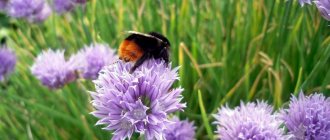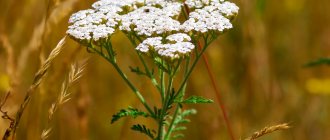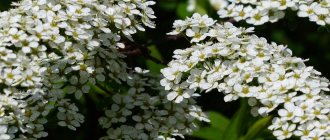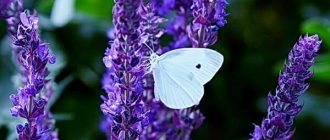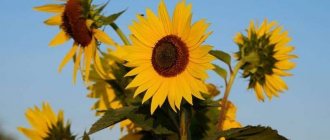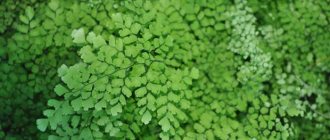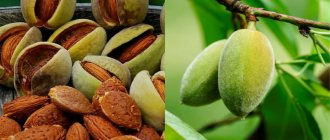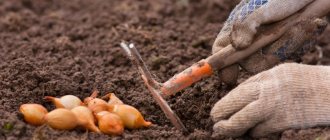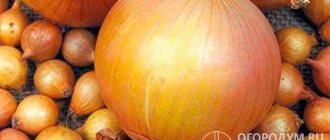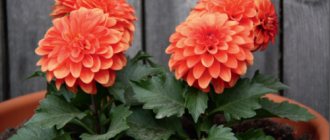What is decorative allium onion, photo and description
Allium is a bulbous perennial plant. Unfortunately, this representative of the flora is not widespread enough and is not particularly popular among domestic flower growers. And it’s really in vain. Today, botanists count more than seven hundred onions, differing in size, time and duration of flowering, color palette of the flower and its shape.
The flowering period is long, about three weeks, but the inflorescences themselves, if not removed at the end of flowering, also look quite picturesque.
Allium flowers decorate the garden, but they are also suitable for cutting, they can be used in summer bouquets or used as dried flowers.
The plant is also attractive because it does not require much space for growth and is an excellent honey plant.
From the name itself it’s easy to guess that it is a close relative of the fairly common onions and garlic that are familiar to us.
The plant is native to Central Asia; it gained popularity in Europe only from the beginning of the nineteenth century.
The spread of ornamental bulbous crops was facilitated by botanists from the Imperial Botanical Garden of St. Petersburg, who, in fact, collected a collection of the most beautiful representatives of the species and began breeding new varieties.
With the exception of the Schubert and Christophe varieties, alliums are resistant to low temperatures, are not particularly demanding on soil, and withstand drought well.
For planting bulbs, you should choose well-lit areas; the plant will feel much more comfortable, and therefore will have a more decorative appearance.
There is no need to dig up the bulbs every year; they can grow in one area for several years.
If desired, allium can be grown even in an ordinary flower pot.
Selection and preparation of a site
Allium giant planting and care photo
Allium blooms most beautifully in sunny, well-lit areas , on southern slopes. Even light partial shade can reduce the color intensity of flowers and leaves. Tall varieties need to be protected from the wind so that they do not break in gusts - it is worth choosing a protected place in advance.
It is preferable for planting in an area with fertile soils , additionally fed with complex mineral fertilizer, with neutral acidity (pH approximately 7.0). More acidic soil requires additional addition of dolomite flour or lime.
Soil permeability is an important condition when choosing a planting site . Allium bulbs can still withstand short-term waterlogging of the soil, but with poor drainage they rot. Although what is good about decorative onions is that among the variety of varieties you can find an exception to the rule: the varieties Farrera and Allium Moli are the most tolerant of moisture and cold.
Landing rules
Let's start with the fact that buying decorative allium onion bulbs is not so easy; not every garden center will offer you at least a couple of varieties of this plant.
There is a much wider selection in online stores, so in order to save time and money, it’s easier to immediately look for sites offering seeds for planting.
It is advisable to plant onions in the fall. As a last resort, they resort to spring planting. Autumn planting is carried out in September or early October, when the air and soil temperatures drop.
The depth of the holes should be approximately twice as large as the height of the bulbs. The prepared wells are slightly moistened.
On one square meter you can plant up to 50 bulbs of large plants or up to hundreds of small ones.
After planting the bulbs, the area is covered with a thick layer of mulch (peat or humus) and watered abundantly. The formation and growth of roots continues until the soil temperature drops below +3 C.
Allium care
It is easy to water and fertilize allium; it rarely requires any other kind of care.
Watering
Allium should be watered sparingly only when the soil is obviously dry. In most cases, it only needs the moisture that can be obtained from precipitation.
In general, too little watering is better for it than too much watering.
Feeding
Allium is fed several times:
- in spring, when the first leaves begin to emerge;
- during flowering, when the first buds appear;
- for the winter.
Moreover, in the first two cases, a mixture of compost and ash is used, and in the latter, a combination of phosphorus and potassium, and in the form of granules not dissolved in water.
Allium in winter
In winter, allium may freeze or suffer from heavy rainfall. The problem can be solved in different ways:
- mulch the soil. In summer this helps against pests and weeds, but in winter it prevents the roots from freezing. The mulch should be plentiful, woody, and laid in a thick layer. Until the snow falls, you need to carefully monitor its condition;
- dig up the bulbs and take them into the warmth. This can be combined with replanting, which is needed every couple of years. Separate the daughter bulbs from the mother bulbs, disinfect them, dry them and keep them until spring.
The first method is well suited for warm areas of the country, the second for those where frosts are severe and snow falls late.
Feeding and watering
The soil should be fertilized when digging, before planting the bulbs. Fertilizers can be used both mineral and compost. The next feeding of plants is done when loosening the soil in the spring. When choosing a fertilizer, you must remember that the plant is very sensitive to potassium deficiency.
You can also feed the plants during the period of bud formation.
At the very beginning of autumn, the last fertilizing of the season is done: wood ash is added.
Alliums do not need abundant watering; they should be moderate and only done if the soil is very dry.
Watch a video about caring for decorative allium onions:
Planting and care
To grow allium, you should choose a sunny location - only in such conditions the plants will demonstrate all their beauty. When grown in partial shade, the leaves become smaller and lose their attractive color, and flowering may not occur.
For tall types of decorative onions, it is worth choosing a place protected from strong gusts of wind or planting the bulbs between small bushes. The south side of buildings and structures is excellent for planting allium.
The bulbs should be strong and dense, without soft spots and an unpleasant putrefactive odor. The surface should be covered with dry brownish scales, there should be no sprouts.
↑ Up,
How and when to plant
The timing of planting bulbs should be selected depending on the flowering period. Bulbs that bloom in spring and bloom in June are planted in the first half of autumn so that the plants have time to adapt to new conditions and build up the root system before the onset of night frosts.
Bulbs are usually planted 3 - 4 weeks before the onset of sub-zero air temperatures. It is not recommended to plant too early - the bulbs will begin to sprout and the plants may die from frost. It is believed that the most suitable time for planting in the middle zone is the second half of October, when during the daytime the thermometer does not exceed 10 degrees Celsius.
↑ Up,
Species that bloom in July - August are planted in the garden in the spring, when the last night frosts have receded and the top layer of soil has warmed up.
To prepare planting holes, you should pay attention to several points. As a general rule, the taller the plants, the more space is left between them. For tall alliums, it is necessary to leave about 40 - 50 cm between the holes; for low-growing varieties and species, 15 - 20 cm will be enough.
If you plan to dig up the bulbs in the fall and store them indoors in the winter, it is better to make holes large enough to accommodate several plants in each hole at once. Decorative onions look great in group plantings.
The bulbs are placed singly if digging is not planned and replanting will be carried out every 2 - 4 years. The depth of the holes will depend on the size of the bulb and the quality of the substrate.
In loose sandy soils, the bulbs can be placed deeper, but in heavy clay soil it is better to reduce the planting depth. For small bulbs, 10 - 15 cm in depth will be enough; for large bulbs, the planting depth is increased to 25 cm.
It is advisable to place a layer of river sand about 3-4 cm thick at the bottom of the planting holes. The bulbs are sprinkled with loose soil mixed with river sand on top, and the soil surface is lightly compacted.
↑ Up,
When planting in autumn, mulch in the form of spruce or pine needles, fallen dry leaves or peat is immediately placed on the site. The layer height can reach 7 - 10 cm. Mulch will protect plants from freezing in winter, and in spring it will inhibit the development of weeds.
When planting in spring, it is advisable to apply mulch after the first leaves appear - approximately 2 weeks after planting the bulbs.
↑ Up,
Land for allium
As with most bulbous plants, the composition of the soil and its ability to drain moisture after rain or watering are important for allium. When planted in low-lying or poorly drained soils, the bulbs rot quickly.
In order to maintain the health of the bulb, many gardeners advise adding mixtures containing a sufficient amount of potassium to the soil - mineral fertilizers, charcoal and ash.
In order to increase the permeability of the soil, river sand is mixed into it in sufficient quantities.
There are no special requirements for decorative onions regarding the composition of the soil, the content of useful substances in it and the level of acidity.
↑ Up,
How to care
When grown in open ground, allium is periodically watered, weeded, and fed. At the base of the plants, the soil is loosened, making it light and well-permeable to moisture and air.
From the moment the bulbs are planted, but before the leaves form, the plants are watered little by little, allowing the soil to dry out between waterings. During this period, the plant is easy to flood.
As the green mass develops, the frequency of watering and the amount of moisture added are gradually increased. During the budding period, watering should be uniform and plentiful. After flowering, as the foliage dies, the frequency of watering is reduced again, allowing the soil to dry out more and more.
↑ Up,
Always water decorative onions at the root, trying not to get on the flowers and buds. For irrigation, use warm rainwater or settled tap water. Watering is carried out in the morning or evening, since drops on the leaf blades during the day can lead to sunburn. Mature plants tolerate drought better than constant waterlogging.
After watering, the soil is loosened and weeds are removed. After weeding, the mulch layer is also renewed. As the buds wither, to prevent the bulbs from wasting their energy on forming seeds or bulbs, the flower stalks are often cut off.
↑ Up,
Since flower stalks are often hollow inside, the cut site is covered with clay, preventing rain moisture from entering and penetrating into the bulb.
After flowering, the onion leaf blades begin to turn yellow and die, but they should not be cut off. Until the last moment, the leaves continue the process of photosynthesis, which means they feed the bulbs. They only get rid of completely yellow leaves by cutting them off at the base with a sharp, sterile garden tool.
↑ Up,
Fertilizer
Allium tolerates a lack of nutrients well and does not need a large amount of fertilizer. The fact is that the necessary emergency reserve is stored in the bulb and the plants can survive unfavorable periods.
The bushes are fed only 2-3 times per season. Fertilizers are applied for the first time with the appearance of the first leaves - at this moment you can use complex mineral fertilizers and well-rotted organic matter. With the appearance of flower stalks, fertilizers are applied a second time - potassium and phosphorus mineral compositions are used. The third feeding is carried out as the buds wither and the formation of daughter bulbs - bulbs.
↑ Up,
If the soil on the site is poor, and the bulbs will winter in the garden, then in early autumn you can add a fourth fertilizer - potassium fertilizer to prepare for the cold.
In addition to standard fertilizers, wood ash is periodically applied - decorative onions always respond to such feeding with gratitude.
↑ Up,
Allium transplant
With age, plants lose their attractiveness - flowering becomes less attractive, inflorescences become smaller and lose their bright color. This is due to the fact that the mother plant forms small daughter bulbs, which begin to compete with the main one for nutrients and moisture. Over time, the bulbs can also go deeper and digging them out becomes a real problem.
To rejuvenate the plants and separate the daughter bulbs, allium is replanted every 3-7 years. The best time for replanting is late summer - early autumn. At this moment, the plants have already faded, but the leaf blades have not yet died off.
Pre-prepare the site and planting holes. Plants are dug up, shaken off the ground, divided if necessary and planted in a permanent place.
↑ Up,
Wintering in the garden
You can leave the bulbs on the site for the winter only if the soil has good moisture permeability - in heavy soils the plants will quickly rot. Most often, allium is not as afraid of frost as it is of excess moisture after autumn rains and melting snow.
Plants need additional protection from frost only in the first year after planting. The area with young bulbs is sprinkled with a small layer of mulch in the fall. Remove the cover in early spring, as soon as the snow cover melts.
↑ Up,
Digging and storing bulbs
If wintering in the garden can result in the death of plants, then before the onset of night frosts, it is better to dig up the bulbs and store them indoors until spring. Digging is carried out after the leaves die.
The bulbs are removed from the soil, shaken off soil residues and dried for 1 - 2 hours in a warm and well-ventilated place. It is best to dry in direct sunlight - ultraviolet light disinfects the surface of the bulbs and kills many pathogens and fungi.
After such treatment, it is advisable to place the bulbs in an oven or a special electric dryer, where they are heated for several minutes at a temperature of 45 - 48 degrees Celsius.
↑ Up,
The storage location for large bulbs should be fairly dry and cool. The air temperature in the room should be 15 - 20 degrees Celsius.
Small, young bulbs are more difficult to tolerate long-term storage and can lose a significant amount of moisture in the process. Such specimens are placed in small containers and sprinkled with barely damp peat, river sand or sawdust to reduce moisture loss.
Every week, the bulbs are taken out and sorted, separating rotten and diseased specimens. Before planting, to disinfect and prevent the development of rot, the bulbs are placed for half an hour in warm water with a small amount of potassium permanganate or a special fungicidal preparation.
↑ Up,
Decorative allium onion: should it be dug up after flowering?
Since the plant is an ephemeroid, the annual digging procedure is not necessary. You can plan a transplant in 5-7 years. Onions overwinter in open ground, without shelter.
But the weather conditions in a particular area should be taken into account: too rainy and cool autumn can cause the development of putrefactive processes in the bulbs. In such cases, it would be rational to dig up the bulbs, dry them and plant them in the ground.
It is recommended to remove the bulbs from the soil after the leaves have completely withered. If the second half of summer is dry and warm, then it is better not to touch the bulbs.
Planting allium
Allium is an unpretentious and resilient plant. Planting allium in open ground does not take much time. Let's take a closer look at the main nuances of planting allium:
It is important to choose a place for allium in the sun and away from the wind. If the presence of the sun affects the brightness of the inflorescences, then the wind is dangerous for the plant by breaking long shoots. The composition of the soil for allium is not important, the only wish is good drainage; the plant will not survive in wetlands. Spring planting of allium is common, as is autumn planting of allium.
The benefits of planting before winter are to improve the health of the bulbs due to exposure to frost. Before planting, dig up the bed with the addition of humus and wood ash. The humus will feed, and the ash will provide the potassium necessary for the bulbous crops.
- The depth to plant allium bulbs depends on their size. Multiply the diameter of the bulb by 3 to get the approximate planting depth. Keep a step of 30-50 cm between holes, depending on the size of the selected allium variety.
- After planting, water the beds and mulch to maintain optimal moisture and prevent the formation of a crust, which prevents sprouts from pecking.
It is noteworthy that some low varieties of allium are planted even at home. To plant allium at home, choose a spacious and tall pot with plenty of drainage holes.
This is interesting: How to properly plant dahlia tubers after wintering - we tell you in detail
Allium bloom
Flowering of almost all varieties begins in May, or more precisely, in the second half of the month. The inflorescences themselves look quite attractive and can have different sizes and colors. The diameter of the inflorescence of the largest of the decorative onions reaches 20 cm in diameter.
The duration of flowering for each variety is different, from a couple of weeks to two months. When choosing planting material, you should take into account that the flowering of some varieties, for example, Allium pulchellum, begins in August.
Growing from seeds
The flowers are bisexual, so the decorative onion Gladiator provides valuable material for generative propagation. Collect seeds after allium blooms, when they begin to fall off. If the material is not ripe, it will not sprout. After collection, place in a cloth bag and place in the refrigerator. In spring, you can sow allium Gladiator in a flower bed. This method of propagation is used only for mass cultivation of planting material.
At home, the method is not productive; from the moment the seeds are planted until the Gladiator allium blooms, it will take 3-4 years. The initial growing season is aimed at the formation of the bulb; when it reaches the required size, the plant will form an arrow and bloom.
Important! With generative propagation, you can get allium Gladiator with different colors, the basis of the hybrid variety is crimson and bright purple, they will appear sporadically in an adult plant.
To speed up the time before allium Gladiator blooms, you can grow seedlings:
- Seeds are planted immediately after collection.
- Fill the containers with a mixture of clay, sand and compost, add calcium.
- Sow the material in shallow furrows.
- Water and place in a room at a temperature of +20 0
- In a favorable environment, the seeds will germinate in 3 weeks.
- They are left indoors until spring, watered periodically.
- In March, they begin to harden allium and gradually lower the temperature.
- At the time of planting, the temperature regime should coincide with that of the open area.
Allium Gladiator is not planted in separate containers; such a procedure is undesirable for bulbous crops
Possible reasons for lack of flowering
Complaints about the lack of flowering onions can be heard very rarely; even novice gardeners can grow a beautifully flowering plant.
However, the cases are different, for example, there may be no flowering:
- in case of incorrect landing;
- for the reason that it is too young;
- when planting in wetlands;
- with severe freezing in winter.
It will also not be possible to obtain abundant flowering with excessive watering.
Features of cultivation
Landing dates
Early flowering onions are recommended to be planted in the fall, and late flowering onions in early spring. Planting times are different for each region. You need to know when garlic is planted in a given area for the winter, and food onions in the spring - this will be the time to work with decorative onions. Planting and care in open ground are simple.
Site selection and soil preparation
Onions are light-loving plants. To grow them, choose a well-lit area near buildings or fences. A flower bed with onions will look impressive if you lay an interesting garden path to it.
- The selected area needs to be dug up,
- remove weeds and remove the top part of the soil (we'll talk about it later).
- We spill the soil with a solution of Fitosporin, according to the instructions for use.
- We place expanded clay drainage into the hole in the soil, cover it with a 15 cm layer of sand, compact it and lay the prepared soil on top.
Soil preparation. For the upper ball of the allaria, we take the soil removed earlier and prepare a nutrient mixture:
- 2 buckets of earth
- 1 bucket of rotted compost,
- 1 glass of lime,
- 2 tablespoons of superphosphate,
- 2 cups wood ash.
- Mix all this thoroughly.
Allium is unpretentious to the soil, but grows better on light loams.
Preparation of planting material
Before planting, the bulb must be carefully inspected for the presence of blossom rot. If they are present, it is necessary to cut off the infected areas to a healthy part with a sterile knife and place them in a solution of potassium permanganate. Leave for half an hour. Dry and plant.
Bulbs can be treated with Yaros. This is a new drug based on natural microorganisms. It has a very beneficial effect on the plant in different phases of development.
When propagated by seeds, they must be stratified - doused with boiling water or soaked in water until the bolls begin to crack. Seeds and bulbs are also soaked in solutions of growth stimulants.
Decorative onions in the garden
Planting decorative onions in open ground
Onion seeds are sown before winter in a separate bed. In winter, they will undergo natural hardening and, if you have high-quality seed material, will have friendly shoots. In the spring, when the plants are fully formed, we transplant the plants along with a lump of earth onto an alpine hill.
Onions grown from seeds bloom only in the third year, and tall species - in the fifth year.
Most alliums are propagated from bulbs or rhizomes. This is due to the fact that breeders offer hybrids, and the seeds will not produce a mother plant.
To plant allium from a mature bulb, at the beginning of autumn you need to make a hole in dry soil that is three times the size of the bulb, plant it, sprinkle it with rotted compost and make a 2-3 cm layer of peat mulch (or fallen oak leaves) on top.
Reproduction methods
Allium is propagated in several ways. The most common vegetative method is propagation by bulbs. It is advisable to dig them up every year, dry them, treat them with growth stimulants and microfertilizers in order to preserve the bulbs until spring; they are placed in dry sawdust and, when warmer, they are planted in a fertilized area. In natural areas, with a climate more favorable for onions, the bulbs are left to overwinter in the soil. It must be remembered that the bulbs tend to divide and with such care they thicken and bloom worse.
Rhizome species are grown for 3-5 years in one place and propagated by dividing the bush. When growing such plants in a perennial crop, the plantings must be thinned out and self-seeding prevented. The optimal planting time for this propagation method would be early spring or late summer, so that the seedlings take root well before frost.
Growing ornamental onions from seeds is very time consuming. Therefore, propagation by seeds is rarely used in private gardening. This method is unacceptable for modern hybrid varieties. There are types of onions that, when propagated by seeds, begin to bloom only in the 3rd to 8th year. Nobody is willing to wait that long.
Different types of decorative onions
The use of allium in landscape design
Different varieties of onions are used to create green compositions that decorate city streets, parks, and garden plots. This plant fits perfectly into pictures of rockeries and alpine hills, stone gardens, it can be planted as border plantings, in group flower arrangements.
When choosing varieties, take into account the flowering period of plants:
- early flowering;
- average flowering period;
- late bloomers.
It is also important to know the height of the plants:
- tall, peduncle length from 80 cm;
- medium-sized, peduncle from 40 to 80 cm;
- short - up to 40 cm.
When planning the planting of ornamental onions, it should be taken into account that the first, basal leaves of the plants quickly turn yellow, and naturally, the attractiveness of the plant decreases. To preserve the decorativeness of the flower bed, other low-growing plants should be positioned so that they cover the allium’s stem.
As for the arrangement of the plants themselves, dwarf varieties of allium look more impressive when planted in groups; tall ones can be planted either in groups or one at a time.
As companion plants, geranium, decorative poppy, hosta, herbaceous peony, irises, and mantle can be planted next to onions.
We invite you to watch an interesting video about the varieties and use of decorative onions:
Vegetative propagation
Allium giant flower photo
Vegetative propagation of allium is the formation of children at the bottom of the mother bulb grown from seed. This process occurs in the third year of life. Separation of grown daughter bulbs must be done very carefully to avoid damage. Plants should be planted at a distance of 50 cm from each other, taking into account the degree of growth of the bulbs. It can grow in one place without replanting for up to 5 years, during which time children grow around the old bulb.
Educational video on how to plant decorative onions:
Reproduction is possible by onion buds - bulbs. To do this, you need to treat them with a growth stimulator and root them in the ground. The characteristics of new plants do not change (stem height, color saturation). This method is optimal when there are a small number of bulbs and the need to speed up the propagation process.
Is it possible to eat decorative allium onions?
Even from the name of the plant one can assume that it is largely decorative. The leaves and bulbs have a fairly pronounced aroma and original taste. Besides. All parts of the plant have healing properties.
Onion leaves can be added in small quantities to spring salads, but the period of edibility of the leaves is limited, it ends with the beginning of the formation of the peduncle. Leaves from the flowering plant are not recommended for consumption.
The bulbs are used for baking and pickling, but they should not be consumed in large quantities; one must take into account the rather high risk of developing an allergic reaction.
The beneficial properties of allium are due to its high content of vitamin C, vitamins E and D. Traditional medicine suggests the use of the product as a means for the prevention of cancer, a general strengthening and immune booster.
Moderate consumption of onions:
- has a beneficial effect on the blood vessels of the brain, relieves spasms;
- helps improve vision;
- cures gastrointestinal diseases;
- helps fight colds;
- onion juice accelerates hair growth.
But taking a large amount of the product (more than 3 g per day) can cause allergies and even poisoning.
Allium varieties and their descriptions
This is one of the representatives of flowering plants, which has more than 500 species. Of course, this is one of the largest genera in the classification system. Allium flowers are divided into varieties. We offer you a description and photo of various types of allium.
Allium acuminatum
It is also known as Hooker's bow and is most common in Canada and the western United States. The inflorescence has the shape of a sphere, and the smell of the plant is exactly like that of a real onion. The allium itself stands on a rather long stalk and has flowers ranging from pink to purple. Most often they are harvested either in early spring or late autumn.
Allium ampeloprasum
Better known as wild garlic - its homeland is Western Asia and Southern Europe. Scientists believe that the very first varieties of this subspecies were grown by ancient people in England near the coast (roughly southwest England and Wales). It has several varieties - onion, garlic and kurrat (Egyptian onion).
Allium ances
One of the wild onions. It is distributed in the western part of the United States - in the states of Nevada, Idaho, Oregon and California. The ideal soil for it is rocky mountains and barren clay. Its flower reaches two centimeters in length, and up to five bulbs emerge from one fruit at a time. The leaves are sickle-shaped and reach a height of 25 cm.
Allium caeruleum
It is also called blue ornamental onion, blue-flowered garlic, etc. It is used as an ornamental plant in suburban gardens and on home windowsills. Allium caeruleum itself comes from Asian countries and grows up to one meter with strap-like stems and small blue balls at the tip of the stem.
Allium cernuum
Also known as a type of wild onion or leek. Its habitat is North America, in areas where dry forests and rocky terrain are especially common.
It has a conical inflorescence that gradually tapers. The leaves reach only 2-4 mm in width, and the flowers can be either white or pink. They ripen in the form of a shaggy sphere, which later splits open and reveals its seeds to the light. This subspecies, unlike others, does not have bulbs in complete inflorescence.
Allium fistulosum
Same as Japanese onion. Its larger cousins resemble leeks, while its smaller variation resembles a regular onion. It is used not only in cooking, but also as a decorative element in landscape design.
Allium neapolitanum
It has many equivalent names, but this does not prevent them from having a single place of origin - Southern Europe, North Africa and the Middle East. It is a valuable tool for gardeners when decorating their garden plot, as it has large, beautiful white flowers that appear in early spring.
Allium stipitatum
It is also called Persian shallot. The epithet “stipitatum” in this case means short stem. It originates in Central Asia, although you will find some of the plants in Turkey, for example. Allium stipitatum has a very tall stem and a white, sphere-shaped inflorescence. In Iran, it is popular as one of the ingredients in food production.
Reproduction methods
You can increase the number of plants in two ways: by sowing seeds or vegetatively.
Seeds can be sown in spring or autumn, picking is done directly into the beds; it is recommended to choose areas well lit by the sun.
Some types of onions, such as giant and stalked ones, germinate only when sown in winter.
Flowering of varieties such as anzura and wild garlic will begin only in the 4-7th year of the plant’s life; by this age, the bulbs will have gained the weight necessary for the reproductive process.
The vegetative method involves planting children that are formed on the mother's bulb.
To propagate rhizomatous species, dividing bushes is used.
Reproduction
Particularly creative gardeners arrange an allium on their site - an onion garden or onion hill, planting several varieties of allium in a small flower garden in combination with perennial flowers: peonies, irises, delphinium, poppy. By the way, decorative onions also look good in the form of a bouquet. Such a composition can stand in a vase for quite a long time. To prevent a strong onion smell from emanating from it, after cutting the stems should be rinsed under running cold water. Many varieties are frost-resistant. They can overwinter directly in the ground, coming back to life again in the spring.
When preparing a flower bed for allium, you need to pay attention to a number of conditions:
- the soil should be neutral, loose, saturated with oxygen;
- the site is collected on a hill to avoid stagnation of water and waterlogging of the soil;
- The flower garden should be well lit by the sun, in which case the color of the leaves and flowers will be especially bright and saturated.
The selected area is dug up in the fall to a depth of 20-25 cm. If the soil is sandy loam or loamy, then fertilizers are scattered over the surface before digging. There is no need to fertilize fertile soil. Early-flowering species are planted in the fall, mid- and late-flowering species in the spring. There are several ways to propagate allium, which allows each gardener to choose the most convenient option.
Seeds
Gardeners know that ordinary onions are a biennial plant, that is, you can get a harvest of bulbs only in the second year after planting the onion seeds. With decorative varieties it is even more complicated; some varieties, especially those with large inflorescences, bloom 6-7 years after planting.
When planting ornamental onions with seeds, it should be taken into account that flowering will occur only after a few years - the specific timing depends on the chosen variety. Species with particularly large inflorescences can bloom only in 6-7 years.
If you or a gardener you know is already growing ornamental onions, you can collect the seeds yourself by selecting the largest and early flowering plants. Selected flower stalks are marked, for example, by tying ribbons to them. After waiting for full ripening, the inflorescences are carefully cut off, threshed and sown in spring or autumn (before winter). Pre-winter (winter) sowing allows the seeds to undergo natural stratification. If you plan to sow seeds in the spring, then the procedure is carried out in compliance with the following steps.
- Artificial stratification. Wrap the seeds in a cloth, moisten them and place them in the vegetable section of the refrigerator for 2-3 days. As the bag dries, it is again sprayed with water.
- Disinfection. Take a few grains of potassium permanganate and dissolve in water. Take enough water so that the color of the solution has a faint, slightly pinkish tint. Dip the seeds into it for a few minutes, then remove and dry until fluffy.
- Sowing seeds. Make shallow grooves in the prepared bed, carefully scatter the seeds into them and cover with a layer of soil 1-2 cm thick.
Taking into account the low germination rate, you can use the seedling method by planting the seeds in a specially prepared substrate of humus, peat and turf soil, filling containers for germination with it. The seed material can be pre-soaked, wait until they hatch and only then plant it in the soil of the containers, covering them with plastic film. This way the soil will dry out more slowly and seedlings will appear faster. The seedlings are picked, hardened, taken outside on warm sunny days, and after the danger of frost has passed, at the age of 60-70 days, they are planted in a prepared flower bed, in an allery.
Among the features of allium propagation by seeds is a possible change in the color of the inflorescences. They usually take on a pale, less saturated hue.
Bulbs
Like all bulbous plants, allium can also be grown using a bulb. It can be purchased from a well-known, well-established manufacturer. Or use a bulb from an old plant. In principle, it is recommended to dig up the root crop every year and put it away for winter storage after the seeds are fully ripe. Store seed at a temperature of 18-20°C in boxes filled with dry sawdust and peat.
1-2 days before the planting date, the bulbs are taken out of the box, sorted, removing weakened, damaged, loose ones and dipped into a fungicide solution for disinfection. Then they are thoroughly dried, and immediately before planting they are heated for 12 hours (at 40°C).
The area dug up in the fall is loosened, leveled, and any fertilizers for garden flowers are added if the soil is not fertile enough. Make holes so deep that the bulb fits completely into it. Drainage is placed at the bottom to drain excess moisture. River sand can be used as it. Having covered the crops, water them well.
Bulbs
Such bulbs do not form on all plants, but you can try to stimulate their formation by trimming the buds and treating the plant with a growth stimulator. They are also planted in holes, the depth of which is determined by the size of the bulb.
Unlike sowing with seeds, with this method of propagation you can admire the flowering bush the very next year after planting. Some specimens may bloom directly in the year of planting. At the same time, all the main characteristics of the mother plant are preserved.
Diseases and their control
Diseases and pests extremely rarely have a negative impact on the condition of bulbous plantings. The pungent odor repels harmful insects and rodents. Of the diseases, the most dangerous is rot; the underground part of the plant can suffer from it if there is excessive soil moisture.
Failure to follow care recommendations, in particular excessive soil moisture, can lead to downy mildew or various types of rot. Onion fly or root mite can also cause damage to the plant.
Preventive measures include:
- warming up the bulbs before planting for 10 hours at a temperature within +40 C;
- treating affected plants with a 2 percent chlorophos solution;
- mulching with peat;
- pollination of the plant with wood ash or tobacco dust.
Diseases and pests
Allium Gladiator is a hybrid variety that gets sick if agricultural conditions are not met.
In unfavorable conditions for growth, it can be affected by neck rot. The first foci of infection appear on dying leaves in the fall. The bulb will not survive until spring if left in the soil. Therefore, the underground part is dug out, dried in the sun and subjected to heat treatment. Turn on the oven at 48-50 0C, place the bulbs on a baking sheet and leave for 60 minutes.
Tobacco thrips is a pest that parasitizes allium. Insecticides are used to control insects. The main threat is the larvae of the onion fly. They get rid of pests with Aktara.
For preventive purposes, allium Gladiator is treated in early spring and at the first signs of the appearance of larvae
The most popular varieties of decorative onions
We indicate the most popular types and varieties of allium in the table.
| Aflatunsky | Tall, peduncle up to 150 cm, inflorescence diameter up to 12 cm. Flowers are pale purple, star-shaped. |
| Gladiator | Considered edible. A close relative of the regular onion. Height - up to 100cm. The color of the inflorescences is blue-lavender. The diameter of the inflorescences can exceed 20 cm. |
| Eros | The bushes are low, 30-35 cm. The color of the inflorescences is from pink to lilac, the diameter of the inflorescence is up to 10 cm. |
| Roundhead | The height of the bushes is up to 60 cm, the inflorescences are oval, pink or purple. Flowering lasts up to four weeks. |
| Blue | The height of the bushes is up to 80 cm, the inflorescences reach 7 cm in diameter, the color of the flowers is bright blue. |
| Yellow, or moth | Low growing, up to 30 cm in height. The inflorescences are not dense, golden in color, flowering lasts 3 weeks. |
| Christophe | Medium height, up to 40 cm in height. Has high decorative qualities. The diameter of the inflorescences is about 25 cm, the color is purple or violet. Flowering lasts about a month. |
| Ostrovsky | Low-growing, the height of the bush is up to 20 cm. The diameter of the inflorescence can reach 10 cm, the color of the flowers is crimson |
| Ivory Queen | The height of the bushes is 25-30 cm. The inflorescences are ivory-colored, up to 12 cm in diameter. It has a very pleasant, rich aroma. The leaves are corrugated, green with a lilac tint. Flowering duration - 3 weeks |
| Giant | The height of the peduncle is approximately 150 cm. The inflorescences are umbrella-shaped, up to 8 cm in diameter, lilac in color. Blooms in June for a month. |
| Kovani | Early flowering, peduncles up to 40 cm long, lush, snow-white inflorescences. Flowering duration is more than 3 weeks. |
Growing ornamental allium onions is not that difficult a task. But only proper care will allow you to get beautiful long-lasting flowering.
How to plan allergy on the site
The selection of varietal diversity is carried out taking into account the height, color of flowers, the beginning and duration of flowering.
It is important to create a composition that will please the eye from spring to autumn. In addition to decorative onions, you can use other plants that help hide imperfections
For example, cereals will distract attention from the yellowing leaves of some varieties
Continuous decoration of a flower bed with blooming flowers can be easily achieved by planning the planting according to flowering dates:
- Allium Moli, Giant – end of May.
- Decorative bow by Ostrovsky, Rosenbach - early June.
- Bow of Christophe, Schubert, Karataevsky - mid-summer.
- Slime, Pretty - second half of summer.
You can include in the composition varieties that are characterized by long flowering. They will decorate the flowerbed when one variety begins to form fruits, and the other does not have time to bloom.
Globemaster onions should be planted for continuous flowering, the violet and purple flowers will attract attention even if there are no other inflorescences for some time. The Gladiator onion will bloom almost until the end of July with purple, lilac spherical umbrellas
